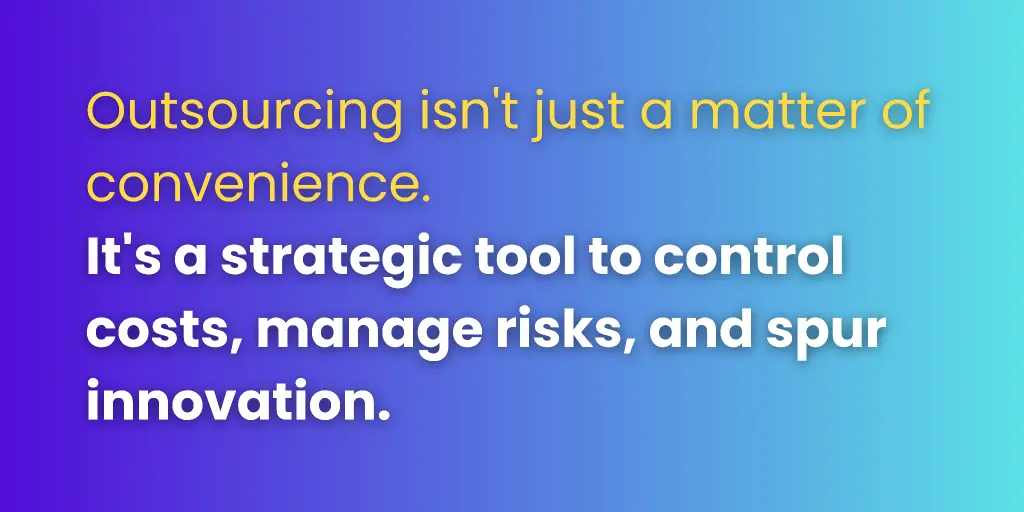In a realm where decisions shape the trajectory of growth and development, the specter of making the right choice looms as a towering barrier. This is an unease not confined to individuals but extends its grip onto businesses, those architects of progress. Prior to any decisive step, the ritual of meticulous contemplation over pros and cons is a rite observed with utmost diligence.
It echoes the sentiment conveyed by Warren Buffett, the sage of business, who proclaimed, “Risk comes from not knowing what you’re doing” .
Outsourcing has emerged as the predominant business model of the 21st century, offering invaluable opportunities to streamline operations, optimize efficiency, and achieve remarkable scalability.
This model saves you time and helps impart essential skills for its effective utilization. For a comprehensive understanding of the myriad advantages outsourcing can bring to your business, we invite you to explore our blog post, “Benefits and Risks of Outsourcing“.
Table of Contents
- What is Outsourcing?
- What are the Major Risks of Outsourcing Services?
- How can you manage the Risks of Outsourcing Services?
- What are we doing to mitigate the Risks of outsourcing Services?
- Conclusion
- How to Outsource?
- Frequently Asked Questions (FAQ)
What is Outsourcing?
At its core, outsourcing involves a strategic approach in which an organization entrusts specific tasks, functions, or processes to external partners or third-party service providers. This collaborative practice allows businesses to leverage the specialized expertise, resources, and capabilities beyond their internal capabilities.
In a dynamic and interconnected business landscape, outsourcing extends beyond traditional boundaries. It encompasses various functions, from IT services and customer support to manufacturing, marketing, and more.

The essence of this approach is a delicate balance that promises both harmony and discord in business health.
By outsourcing tasks not central to a company’s core expertise, businesses can tap into specialized knowledge and resources, ultimately enhancing their overall efficiency and effectiveness. This can involve contracting services ranging from customer support to manufacturing, allowing companies to concentrate on refining their unique value propositions and expanding their market presence.
Outsourcing isn’t merely a tactical move; it’s a strategic maneuver designed to free up resources, reduce costs, and accelerate growth. However, like any strategic decision, it carries its fair share of risks that necessitate careful consideration and planning.
To explore this topic further and discover strategies for overcoming these challenges, we suggest reading our blog post, “Risks of Foreign Outsourcing and How to Overcome Them”.
What are the Major Risks of Outsourcing Services?
Every step into the unknown, as elucidated by the visionary Peter Drucker, bears the hallmark of a courageous plunge. Indeed, new decisions are the sculptor’s chisel that molds a company’s destiny, accompanied by the whisper of risk. With a scalpel in hand, let us dissect the major risks, including those associated with remote work, lurking beneath the surface of outsourcing’s facade.
Quality Compromise
Like a Jenga tower built on shifting sands, outsourcing’s promise might waver under the weight of quality concerns. The masterpiece of brand reputation, painstakingly painted over time, risks being tainted by a single brushstroke of subpar workmanship, whether it occurs on-site or in remote locations.
When an organization delegates tasks to an external entity, there’s a potential trade-off between quality and cost. While outsourcing can indeed lead to cost savings, the allure of reduced expenses can sometimes cloud the judgment of decision-makers. In the pursuit of lower costs, companies might compromise on the quality of work or services provided by the external provider, even when remote work is involved.
Security Vulnerabilities and Safeguarding Software and Service Integrity
In the age of digital dominion, the sharing of secrets is a dance with shadows. Handing over the key to the treasure trove of software and data beckons hackers and cyber malefactors to the feast, whether this exchange occurs on-site or via remote access.
Modern businesses run on data and critical assets – customer information, proprietary algorithms, financial records, and more. When outsourcing involves sharing such sensitive information and software with external providers, the potential for breaches and security vulnerabilities increases. It’s crucial to assess the security practices and protocols to ensure that your valuable information and software remain safeguarded.
Communication Challenges and the Impact on Software and Service Delivery
The business world, a tapestry woven with threads of diverse cultures, finds itself occasionally entangled in miscommunication’s web. The language of intent lost in translation, and a symphony turns discordant.
Communication lies at the heart of successful partnerships. Communication challenges can arise when collaborating with partners from different geographic locations or cultural backgrounds, communication challenges can arise. These challenges might range from language barriers to differences in communication styles and time zones. Without effective communication, misunderstandings can lead to delays, errors, and project setbacks.
Loss of Control
An enterprise’s reins handed over to another, akin to a trapeze artist’s grasp on the swing of governance, might evoke a sense of vertigo. Control becomes an apparition, an entity of memory.
Outsourcing involves entrusting specific tasks or processes to external providers. While this can result in efficiency gains, it might also give rise to concerns about losing control over those tasks. This loss of control can manifest in various ways, including the inability to directly manage and oversee the outsourced activities. For businesses accustomed to maintaining close control over every aspect of their operations, this shift can be unsettling.
Hidden Costs and Managing Financial Aspects of Software and Service
Beware the mirage of frugality that shrouds outsourcing’s entrance. Beneath the oasis of savings lies an unfathomable abyss of costs, from the toll of software licenses to the hours lost in coordination.
One of the primary drivers behind this strategy is often cost reduction. However, it’s essential to recognize that obtaining external help comes with its own set of costs, some of which might not be immediately apparent. These hidden costs can include expenses related to communication tools, travel, legal consultations, and project management efforts. Failure to account for these costs can lead to budget overruns and erode the anticipated savings.
Legal and Compliance Risks
Across the global stage, the laws that govern company perform a complex ballet. A misstep in understanding or adhering to the local choreography may summon the stern gaze of legal authorities.
This strategy often involves interactions with partners located in different jurisdictions, each with its own legal and regulatory landscape. Failure to navigate these intricacies correctly can result in legal and compliance risks. These risks might involve violating data protection regulations, intellectual property rights, or industry-specific standards. To mitigate these risks, thorough due diligence and legal consultation are crucial.
Dependency Concerns
Like a plant leaning too heavily on its supporting trellis, a company reliant on a solitary external partner teeters on shaky ground. The disruption or withdrawal of that partner threatens the entire ecosystem’s equilibrium.
Relying heavily on a single external partner can introduce dependency concerns. If that partner encounters financial difficulties, operational disruptions, or decides to discontinue their services, your business could find itself in a precarious situation. Diversification of partnership with external providers can help mitigate this risk by spreading reliance across multiple partners.
To learn about effectively mitigating outsourcing risks and minimizing their adverse impacts, please check out our blog post, “How can the Risks of Outsourcing be Mitigated?“.
How can you manage the Risks of Outsourcing Services?

Navigating the seas of outsourcing, much like skilled sailors charting their course through uncertain waters, requires a blend of expertise, planning, and strategic thinking.
Just as seasoned seafarers employ due diligence, strategic contracts, clear communication, prudent organization, and careful selection of vendors, providers, and developers, your company can adeptly manage and mitigate the risks and issues associated with outsourcing through these tried-and-true strategies.
For more information on how to overcome the risk of outsourcing and mitigate the negative effects, “How can the Risks of Outsourcing be Mitigated “.
Thorough Due Diligence for Informed Business Development
Embarking on outsourcing is like exploring a new land—a realm of opportunities and uncertainties shaping your company’s growth. Just as explorers meticulously plan routes and study terrain, businesses must conduct due diligence, using top technology to navigate outsourcing complexities and guide your development journey while addressing potential risks, empowered by cutting-edge tools.
Robust Contracts and Agreements
Contracts serve as the wind in your sails, propelling your company’s voyage toward development. Create agreements that outline responsibilities, expectations, and contingencies based on past negotiations. These legal documents, shaped by technology solutions, define expectations, responsibilities, and engagement terms with a vendor, service provider, or developer, much like a map guiding sailors.
Crafted carefully and supported by technology, these agreements provide a safety net against unexpected challenges, ensuring both parties use technology tools to align objectives and effectively manage outsourcing risks, including software-related issues.
By reinforcing your journey with strong contracts, backed by technology, your company sets a course for success and risk mitigation, supporting overall business development while effectively addressing potential outsourcing challenges.
Open Communication Channels
Just as communication is crucial between sailors on a ship, it’s equally vital in outsourcing and vendor partnerships. The turbulent waters of language barriers, time zones, and cultural nuances can obscure your path. Effective communication, powered by the best technology tools, acts as your guiding star, ensuring that you and your external partner, vendor, service provider, or developer are in sync.
By maintaining open channels for dialogue, you confirm that your journey remains on course and avoids the reefs of miscommunication, directly impacting your development strategy and addressing potential challenges.
Prudent Organization and Diversification
In the realm of outsourcing, as in sailing, the wisdom of “Don’t put all your eggs in one basket” holds true, particularly when it comes to a vendor, service provider, or developer. Diversifying your outsourcing and vendor partnerships spreads the risk of outsourcing and ensures your company isn’t overly dependent on a single entity.
This strategy, akin to diversifying investments, safeguards your operations from the impact of any one partner’s challenges, directly safeguarding your development trajectory. Additionally, prudent organization—meticulous planning and resource allocation—can fortify your strategy and vendor relations, allowing you to proactively manage potential challenges and foster company development.
Effective communication is your guiding star, ensuring that you and your external partners and vendors are in sync. By maintaining open channels for dialogue, you ensure that your journey remains on course and avoids the reefs of miscommunication, directly impacting your development strategy.
What are we doing to mitigate the Risks of Outsourcing Services in 2023?
As captains of our business vessels, we take outsourcing risks seriously while charting a course for company development. Drawing on our collective experience, here’s how we’re proactively addressing potential challenges and fostering development:
Stringent Vetting Process
We employ a rigorous vetting process to select outsourcing partners. Our evaluation includes an assessment of their expertise, financial stability, and previous client feedback.
Bespoke Contractual Framework
Our contracts are meticulously crafted to define project scope, quality expectations, data security measures, and dispute resolution mechanisms. This ensures a shared understanding and accountability.
Continuous Performance Assessment
We maintain an ongoing assessment of our outsourcing partners’ performance. Regular audits and evaluations help us identify and address any deviations from established standards.
Diversification of Partnerships
We recognize the importance of reducing dependency on a single partner. Through strategic diversification, we spread our outsourcing relationships to minimize risk concentration.
Technological Reinforcement
Embracing cutting-edge technologies helps us bolster data security, streamline communication, and enhance the overall efficiency of our outsourcing endeavors.
Conclusion
The orchestra of growth, while synchronized to the rhythm of outsourcing challenges, finds its harmony in deftly navigating them. These challenges, akin to currents that may buffet a ship, can indeed be harnessed to sail toward horizons of innovation and prosperity. By understanding the nuances of outsourcing challenges and implementing effective mitigation strategies, businesses can transform obstacles into catalysts for strategic advancement.
How to Outsource?
Client’s Idea
Our partnership will start by scheduling a call with you to understand your business requirements and goals. Based on all the information, we will prepare a customized proposal with a scope of work, pricing, and other relevant details. The proposal will also highlight the benefits of outsourcing digital marketing positions, such as access to a more incredible talent pool and efficacy in executing your projects while being cost-friendly.
Setting up the right team
Once we sign the Agreement, our HR department will start with the screening and recruitment process, so we can set up a team of marketing experts to work on your project. Once we get a pool of qualified candidates, we will present them to you for review. You would be able to interview and evaluate the candidates in the last round to determine if they are a good fit for your business.
Facilitating and onboarding
Once you get your dedicated Belgrade team who works exclusively for you, we will start the onboarding process. This would include setting up their office and workspace, providing necessary equipment or tools, and ensuring they receive the required training.
Execution
The marketing team will execute the project as per the agreed-upon SLA. The team will use various methods to generate leads, including email marketing, social media outreach, cold calling content creation, running PPC campaigns, etc. We are keeping up to date with all the necessary information quickly since you have a designated project manager explicitly working for your business/project.
Maintenance and training
We will provide comprehensive training for the newly recruited marketing team. This training will include product knowledge, sales techniques, and other relevant skills. We will ensure that your freshly established marketing team is equipped with the tools and resources necessary to succeed in the industry in which you operate.
Managing and reporting
As mentioned, each project has from our side project manager who ensures everything runs smoothly in the office. He is your single point of contact, overseeing the project, so you can rest assured that all your requirements will be met and you will receive regular updates on the progress of your project.
Frequently Asked Questions (FAQ)
What is Outsourcing?
Outsourcing refers to the strategic practice of entrusting specific business functions or tasks to external providers or third-party service providers. This allows companies to focus on their core competencies while leveraging the expertise and resources of specialized vendors. Commonly outsourced functions include customer support, IT services, manufacturing, and more.
What are Major Risks of Outsourcing Services in 2023?
Outsourcing comes with several potential risks that businesses should be aware of:
Quality Compromise: The risk of a decline in the quality of work when tasks are handed over to external parties.
Data Security Vulnerabilities: Sharing sensitive data with partners can expose businesses to data breaches and security threats, impacting work integrity.
Communication Challenges: Differences in culture, language, and time zones can hinder effective communication, affecting collaborative work.
Loss of Control: Entrusting tasks to external providers might lead to a perceived loss of control over operations.
Hidden Costs: Unforeseen expenses such as communication tools or management efforts can inflate costs.
Legal and Compliance Risks: Operating in different jurisdictions can expose companies to legal and compliance challenges.
Dependency Concerns: Overreliance on a single outsourcing partner can lead to vulnerabilities if that partner faces disruptions.
How can you manage Risks of Outsourcing Services in 2023?
Managing outsourcing risks requires careful planning and strategic execution:
Thorough Due Diligence: Conduct extensive research on potential partners to understand their capabilities and track record.
Robust Contracts and Agreements: Craft well-defined contracts that outline expectations, quality standards, and dispute resolution mechanisms.
Open Communication Channels: Establish clear lines of communication to foster transparency, alignment, and issue resolution.
What are we doing to mitigate Risks of Outsourcing Services in 2023?
In the realm of outsourcing, the risks are the sentinels guarding the gates to rewards. By understanding their presence and wielding the strategies to mitigate them, businesses can stride confidently into the world of outsourcing, leveraging its potential for growth and transformation.
We have implemented comprehensive strategies to mitigate outsourcing risks when you hire our services:
Stringent Vetting Process: Our partners undergo rigorous evaluation to ensure expertise and reliability.
Bespoke Contractual Framework: Our contracts define project scope, quality benchmarks, and data security measures.
Continuous Performance Assessment: Regular audits and evaluations help us maintain alignment with established standards when you hire our services.
Diversification of Partnerships: We avoid over-reliance on a single partner, which benefits you when you hire our services.
Technological Reinforcement: We leverage advanced technologies to enhance data security, communication, and efficiency, benefiting you when you hire our services.
How to Outsource Services and Hire Outsourced Teams in 2023?
It all starts with your idea. Our team is here to support you and teach you how to best develop and implement your idea in your business, all while saving you valuable time. However, before we begin, we suggest you schedule a consultation with our team, who will provide you with the necessary guidance and answer any questions you may have about hiring outsourced services or teams. We understand that time is a precious resource, and our goal is to help you optimize its use while achieving your business objectives.



